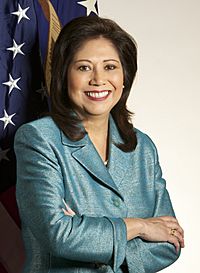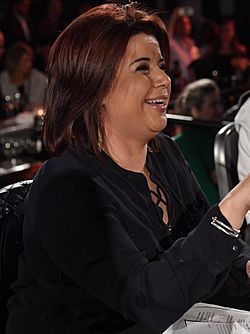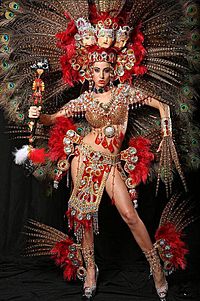Nicaraguan Americans facts for kids
  |
|
| Total population | |
|---|---|
| 429,501 (2019) 0.13% of the U.S. population (2021)  |
|
| Regions with significant populations | |
| Metropolitan Miami, Greater Orlando, Jacksonville, Greater Los Angeles, San Francisco Bay Area, New York City, New Jersey, Washington Metro Area, San Diego, Inland Empire, Houston, Greater San Antonio, Dallas–Fort Worth, New Orleans Metro, Charlotte metropolitan area, Baltimore, Las Vegas Valley | |
| Languages | |
|
|
| Religion | |
| Predominately Roman Catholic, minority Protestantism | |
| Related ethnic groups | |
| Latino Americans, Honduran Americans, Guatemalan Americans, Salvadoran Americans, Costa Rican Americans, Panamanian Americans, Spanish Americans |
A Nicaraguan American is a person living in the United States who has family roots in Nicaragua. People sometimes call them "nica" or "nicoya" for short.
In 2010, there were about 348,202 Nicaraguan Americans. This group is the eleventh largest Hispanic group in the U.S. and the fourth largest from Central America.
Most Nicaraguan Americans, more than two-thirds, live in either California or Florida.
In California, many Nicaraguan Americans live in the Greater Los Angeles Area and the San Francisco Bay Area. You can also find large groups in the Inland Empire and cities like Sacramento, San Diego, and San Jose.
In Florida, about 90% of Nicaraguan Americans live in the Miami Metropolitan Area. In fact, Miami-Dade County is home to 30% of all Nicaraguan Americans in the United States!
Contents
Coming to America: A History of Immigration

Nicaraguans have been moving to the United States in small numbers since the early 1900s. However, many more arrived in the last 30 years of the 20th century. Most Nicaraguan communities are found in three main areas: Miami, Los Angeles, and the San Francisco Bay Area. Some wealthier Nicaraguan Americans also live in the New York metropolitan area.
Between 1976 and 2002, over 193,000 Nicaraguan immigrants were officially allowed to live in the U.S. as permanent residents. This means they were given legal status to stay.
Before 1970, records of Nicaraguan immigrants were often grouped with other Central American countries. However, by 1970, about 28,620 Nicaraguans were living in the U.S.
During the 1980s, many Central Americans, including Nicaraguans, sought refugee status in the U.S. This was a difficult time for many seeking safety.
A big wave of immigration happened after 1984. In 1998, a terrible storm called Hurricane Mitch left over two million Nicaraguans without homes. Because of this, many Nicaraguans were given permanent residency or temporary protected status (TPS). This allowed them to live and work in the U.S. safely.
By 1990, about 168,659 of the 202,658 documented Nicaraguans in the U.S. were born in Nicaragua. Many of these immigrants were working-age adults who had good education and often held office jobs before moving. They also tended to come from larger families with higher incomes.
Why People Moved: Reasons for Immigration
A major reason Nicaraguans came to the U.S. was the Sandinista revolution in the mid-1970s and the Contra war that followed. These conflicts caused many people to leave their homes.
The first large group of about 120,000 Nicaraguans came to the U.S. because of changes made by the Sandinista government from 1979 to 1990. These people were often wealthy landowners, business owners, and managers. Many of them already had business ties in the U.S., especially in Miami.
Another large group of Nicaraguans, mostly blue-collar workers, came in early 1989. They also wanted to escape political problems and a very difficult economy in Nicaragua. By the late 1980s, the war, Hurricane Joan in 1988, and a severe drought in 1989 had left Nicaragua in ruins. Many of these immigrants settled in poorer parts of Miami.
Many Nicaraguans also moved to escape poverty. In some areas, like Santa Clara County, California, many Nicaraguan families have at least one person who owns their own business or works for themselves.
Culture and Traditions
Nicaraguan Americans mostly speak Spanish and are mainly Catholic. They celebrate religious festivals for their patron saints with parades and special events. These celebrations are also a way for them to share their art and culture.
Important festivals in Florida include Santa Ana, San Sebastian, La Purisima, San Jeronimo, and La Griteria. Nicaragua is a country with strong traditions. Most Nicaraguans see themselves as socially conservative, no matter where they live in the U.S.
Where Nicaraguan Americans Live: Demographics

Besides California and Florida, you can find Nicaraguan Americans in New York City, New Orleans Metro, and the Washington Metropolitan Area. Cities like Charlotte, Houston, Jersey City, and Camden, New Jersey also have noticeable Nicaraguan populations.
Wisconsin has a special connection with Nicaragua as a "sister state." In the past, programs for jobs and student exchanges brought the first Nicaraguans to settle in Wisconsin.
States with Many Nicaraguan Americans
Here are the top 10 states with the most Nicaraguan Americans, based on the 2010 Census:
- Florida - 135,143
- California - 100,790
- Texas - 19,817
- New York - 13,006
- New Jersey - 8,222
- Maryland - 8,196
- Virginia - 7,388
- Louisiana - 6,390
- North Carolina - 4,964
- Georgia - 4,787
Major Areas with Nicaraguan Americans
These are the areas with the largest populations of Nicaraguans, according to the 2010 Census:
- Miami-Fort Lauderdale-West Palm Beach, FL MSA - 118,768
- Los Angeles-Long Beach-Santa Ana, CA MSA - 40,607
- San Francisco-Oakland-Fremont, CA MSA - 30,807
- New York-Northern New Jersey-Long Island, NY-NJ-PA MSA - 17,987
- Washington-Arlington-Alexandria, DC-VA-MD-WV MSA - 14,187
- Riverside-San Bernardino-Ontario, CA MSA - 9,793
- Houston-Sugar Land-Baytown, TX MSA - 9,496
- New Orleans-Metairie-Kenner, LA MSA - 5,310
- San Jose-Sunnyvale-Santa Clara, CA MSA - 4,540
- Orlando-Kissimmee-Sanford, FL MSA - 4,083
- Dallas-Fort Worth-Arlington, TX MSA - 3,964
- Atlanta-Sandy Springs-Marietta, GA MSA - 3,719
- Las Vegas-Paradise, NV MSA - 3,587
- Sacramento-Arden-Arcade-Roseville, CA MSA - 3,269
- Philadelphia-Camden-Wilmington, PA-NJ-DE-MD MSA - 3,163
- Chicago-Joliet-Naperville, IL-IN-WI MSA - 2,928
- Tampa-St. Petersburg-Clearwater, FL MSA - 2,589
- Phoenix-Mesa-Glendale, AZ MSA - 2,169
- San Diego-Carlsbad-San Marcos, CA MSA - 2,025
- Charlotte-Gastonia-Rock Hill, NC-SC MSA - 1,912
- Vallejo-Fairfield, CA MSA - 1,750
- Austin-Round Rock-San Marcos, TX MSA - 1,714
- Seattle-Tacoma-Bellevue, WA MSA - 1,635
- San Antonio-New Braunfels, TX MSA - 1,547
- Boston-Cambridge-Quincy, MA-NH MSA - 1,438
Cities with Many Nicaraguan Americans
Here are some U.S. cities with the largest number of Nicaraguan Americans (2010 Census):
- Miami - 28,618
- Los Angeles - 15,572
- Hialeah, Florida - 10,410
- San Francisco - 7,604
- Fontainebleau, Florida - 6,738
- Houston, Texas - 4,226
- Kendale Lakes, Florida - 3,560
- Tamiami, Florida - 3,476
- Sweetwater, Florida - 3,102
- San Jose, California - 2,917
- Kendall, Florida - 2,629
- The Hammocks, Florida - 2,391
- Kendall West, Florida - 2,265
- Miami Gardens, Florida - 2,134
- West Little River, Florida - 2,112
- Richmond West, Florida - 2,039
- Miami Lakes, Florida - 1,772
- Hayward, California - 1,745
- Miramar, Florida - 1,691
- South San Francisco, California - 1,639
- South Miami Heights, Florida - 1,585
- Metairie, Louisiana - 1,462
- Pembroke Pines, Florida - 1,423
- Homestead, Florida - 1,354
- Hialeah Gardens and Hollywood, Florida - 1,321
Cities with a High Percentage of Nicaraguan Americans
These U.S. cities have the highest percentage of Nicaraguans compared to their total population (2010 Census):
- Sweetwater, Florida - 22.98%
- Fontainebleau, Florida - 11.27%
- Miami, Florida - 7.16%
- Richmond West, Florida - 6.38%
- Kendale Lakes, Florida - 6.34%
- Tamiami, Florida - 6.29%
- Kendall West, Florida - 6.26%
- West Little River, Florida - 6.09%
- Hialeah Gardens, Florida - 6.08%
- Brownsville, Florida - 5.66%
- Stock Island, Florida - 5.66%
- Medley, Florida - 4.89%
- Princeton, Florida - 4.89%
- Gladeview, Florida - 4.83%
- The Hammocks, Florida - 4.69%
- Hialeah, Florida - 4.63%
- South Miami Heights, Florida - 4.44%
- University Park, Florida - 4.32%
- Rollingwood, California - 4.14%
- Palmetto Estates, Florida - 4.13%
- Colma, California - 4.02%
- Miami Lakes, Florida and Country Walk, Florida - 3.90%
- The Crossings, Florida - 3.89%
- Country Club, Florida - 3.76%
- Westwood Lakes, Florida - 3.72%
Notable Nicaraguan Americans
Many Nicaraguan Americans have become famous in different fields:
- Alex Blandino, MLB player
- Marvin Benard, MLB player
- Maurice Benard, actor
- Nastassja Bolívar, beauty pageant winner
- Randy Caballero, professional boxer
- Barbara Carrera, actress
- DJ Craze, DJ
- Luis Enrique, singer
- Bill Guerin, NHL hockey player
- Bianca Jagger, human rights advocate
- Diana López, taekwondo athlete
- Mark López, taekwondo athlete
- Steven López, taekwondo athlete
- Dennis Martínez, MLB player
- Christianne Meneses Jacobs, children's magazine publisher
- Ana Navarro, political commentator
- Eddy Piñeiro, NFL player
- Claudia Poll, Nicaraguan-born swimmer
- Silvia Poll, Nicaraguan-born swimmer
- Tammy Rivera, singer
- J Smooth, hip hop and reggaeton singer
- Hilda Solis, former U.S. Secretary of Labor
- T-Bone, rapper
- Eve Torres, professional wrestler
- Donald Vega, jazz musician
- Shakira Barrera, actress
See also
 In Spanish: Inmigración nicaragüense en Estados Unidos para niños
In Spanish: Inmigración nicaragüense en Estados Unidos para niños
- Nicaragua–United States relations



